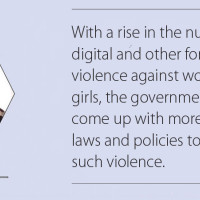- Monday, 1 December 2025
Angry Teenagers
Garima Dhakal
You must have seen an angry teenager. Anger is often seen as one of the defining features of young people. We notice it in loud arguments and slammed doors. Even in the silence of a teen who refuses to speak, the anger is loud. There are deep psychological reasons that explain why youths experience anger so strongly.
One major reason lies in the way the brain develops during adolescence. The part of the brain that controls reasoning and self-control, which is called the prefrontal cortex, matures more slowly than the emotional centre, the limbic system. This imbalance makes it easier for young people to react quickly. They sometimes have bursts of anger before they have thought through the consequences. It is not that young people want to be reckless but their brains are still learning and processing how to balance emotion like anger with reason.
Anger in youth is rarely just about biology. Psychologists explain that anger often hides other emotions like sadness, fear, or even shame. When a teenager feels rejected by peers, misunderstood by parents, or humiliated at school, those feelings may come out as anger. This is because it feels safer to appear tough than vulnerable. Studies show that this pattern is especially common among boys who are more likely to express pain through aggression. While the girls channel this more quietly, it is equally harmful. In this sense, anger acts like a mask, covering young people’s pains and sufferings.
Stressful life conditions add even more fuel to this fire. Family conflicts, bullying, economic hardship, or heavy academic pressure can build a sense of frustration in the youths. This can easily turn into rage. Research has shown that teenagers with low self-esteem or symptoms of anxiety and depression are more likely to show anger. In the meantime, supportive families, optimism, and confidence act as protective shields for these youths. In other words, anger is not just about what happens inside a teen’s head, but also about the environment that surrounds them and the pressures they face each day.
Relationships also play a powerful role. Young people who feel securely attached to their parents or caregivers tend to regulate their emotions better. They trust that they will be heard and cared for, so they do not need to rely on anger as their first response. On the other hand, insecure or dismissive relationships often tend to lead to greater hostility and emotional outbursts. How adults respond in moments of conflict also makes a big difference. Warmth, empathy, and acceptance help to calm teens.
Harsh punishments or dismissal often push them further into these outbursts. Studies even suggest that maternal and paternal responses shape boys and girls differently, showing just how delicate these bonds can be. In today’s digital world, anger is spreading faster than ever. Research on social media shows that angry posts travel more quickly than joyful ones. A single outburst online can trigger anger among a large group of youths at once. This digital echo adds another layer of intensity to this already challenging stage of life for the youth.
Anger in youth should not be dismissed as destructive. It can also be a signal that a change is needed in their families, school, or society. Programmes that teach coping skills such as relaxation, problem-solving and positive communication have been shown to reduce the anger of the teens and even improve their self-esteem. Parents and teachers who exhibit calmness and empathy provide the strongest lessons to these youths. When adults truly listen and guide the teens instead of remaining silent, young people begin to learn that their anger can be managed and they can be understood.
The psychology behind angry youths reminds us that this emotion is not simply a problem to be solved but also a message to be heard. Anger is often a cry for love, care and understanding. If we help the teens to manage their anger, we help them grow into healthier and more resilient adults.

















